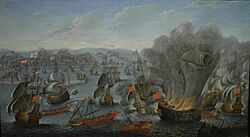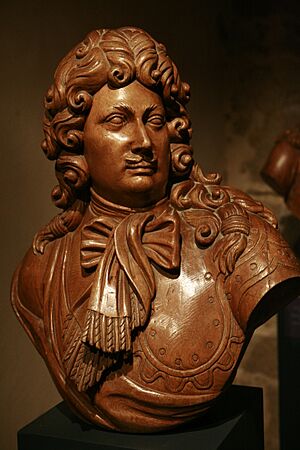Louis Victor de Rochechouart, Duke of Vivonne facts for kids
Quick facts for kids Louis Victor de Rochechouart |
|
|---|---|
| 2nd Duke of Mortemart Duke of Vivonne |
|
 |
|
| Engraving of Louis Victor | |
| Spouse(s) | Antoinette Louise de Mesmes |
| Issue | |
| Gabrielle, Abbess of Beaumont-lès-Tours Charlotte, Duchess of Elbeuf Louis, Prince of Tonnay-Charente Marie Élisabeth, Countess of Castries Louise Françoise, Abbess of Fontevrault Gabrièlle Victoire, Duchess of Lesdiguières |
|
| Full name | |
| Louis Victor de Rochechouart | |
| Noble family | House of Rochechouart |
| Father | Gabriel de Rochechouart de Mortemart |
| Mother | Diane de Grandseigne |
| Born | 25 August 1636 Hôtel de Rochechouart, Paris, France |
| Died | 15 September 1688 (aged 52) Chaillot, Paris, France |
Louis Victor de Rochechouart, 2nd Duke of Mortemart and Duke of Vivonne (born August 25, 1636 – died September 15, 1688) was a French military leader and nobleman. He belonged to the very old and important House of Rochechouart family. His father was a childhood friend of Louis XIII, a king of France.
Louis Victor had famous sisters too. One was Gabrielle de Rochechouart de Mortemart, known for her beauty. Another sister was Madame de Montespan, who became a close companion to Louis XIV, the Sun King. Louis Victor himself became a Marshal of France, a very high military rank.
Contents
His Life and Military Career
Louis Victor was the only son of Gabriel de Rochechouart de Mortemart. His family, the House of Rochechouart, was one of the oldest noble families in France, second only to the royal family. They were a powerful family dating back to the 800s. Their family name comes from their home, Rochechouart.
His sisters were also well-known. His oldest sister, Gabrielle, was famous for her beauty. His sister, Françoise, became the official mistress of King Louis XIV in 1667. She had seven children with the king. His youngest sister, Marie Madeleine, chose a religious life. She became the Abbess of Fontevraud, a very old and rich convent. People called her the "Queen of Abbesses."
Louis Victor was born in Paris on August 25, 1636. He was given the title Count of Vivonne. This title was later made into a duchy, which is why he is better known as the Duke of Vivonne. As a child, he had the special right to play with the young Dauphin, who would become King Louis XIV. Later, he was known as one of the bravest and wittiest men at Louis XIV's royal court.
Joining the Army
In 1653, Louis Victor joined the military as a Captain in the Royal Guard. He fought bravely in Flanders and Artois under a famous general, Henri de La Tour d'Auvergne. He was especially noted for his role in the sieges of Landrecies, Condé-sur-l'Escaut, and Valenciennes. A commander named Roger de Rabutin praised Louis Victor's courage during the battle at Condé.
Later, he became a Colonel and served in Italy twice. He then asked to join the Marines. He worked with the Duke of Beaufort and was later given the important title of Grand Master of Navigation.
Leading the Galleys
Louis Victor became a Captain of vessels and a Peer of France in 1663. He went on an expedition to Jijel in Algeria. When France declared war on Spain in 1667, Louis Victor showed great bravery in Flanders, even with the king watching. When he wasn't fighting on land, he was leading ships. In March 1669, he became the général des galères (General of the Galleys). This promotion was partly due to his sister, Madame de Montespan, who was then Louis XIV's mistress.
After this, he attacked the Turks who were fighting the Venetians at the siege of Candia. When the Duke of Beaufort died, Louis Victor took over his ships and continued the fight. He was injured in combat on July 24, but he realized he couldn't make the Turks retreat. So, he pulled back to Toulon. In 1671, he was put in charge of protecting the southern coast of France from pirates.
In 1672, during the French War with Holland, he took part in the famous crossing of the Rhine River. His horse tripped, and he fell into the river. At the same time, he was shot in the arm. He had to be carried away, but he was proud of his family's bravery. In 1673, he was important in the siege of Maastricht. The next year, he was made Governor of Champagne.
Viceroy of Sicily
In 1675, King Louis XIV sent Louis Victor to Messina, a city in Sicily. The people there had revolted against Spanish rule. By February 11, he had sent help to the town. On August 2, 1675, he was made a Marshal of France. He became known as the Maréchal de Vivonne. In August 1676, he was made the Viceroy of Sicily. A Viceroy is like a governor who rules a country or province as the representative of a king or queen.
From Sicily, he sent naval forces to help French admirals fight the Dutch in the Battle of Augusta and Battle of Palermo. Louis Victor told the local people that the king cared deeply about them. He said the king would "take them definitively under his powerful and friendly protection."

However, in January 1678, the king ordered Louis Victor to leave Messina. This left the city to defend itself. After the French left Messina in April 1678, many French soldiers who remained were killed by Sicilians. After this, Louis Victor stopped working at sea.
Life at Court
After his successful military career, Louis Victor returned to Paris. He was given the title Premier gentilhomme de la Chambre du Roi, which means "First Gentleman of the King's Bedchamber." This was a very important position at court. By this time, his sister's influence at court had lessened.
Despite this, Louis Victor had an interesting life at court and became a close friend of the king. One writer, the duc de Saint-Simon, said that "Monsieur de Vivonne had infinite spirit and entertained it without fear; he pleased the king with a hundred stories."
Louis Victor was also friends with the famous playwright Molière and the writer Nicolas Boileau. He even introduced Boileau to the king.
His only son, Louis, died in April 1688. This loss deeply affected Louis Victor. He died in Chaillot at the age of 52. His grandson, Louis de Rochechouart de Mortemart (1681–1740), took his place.
His daughter, Marie Élisabeth, was a lady-in-waiting to her cousin, the Duchess of Orléans. They were very close.
Louis Victor's wife, Antoinette Louise, lived longer than him and died in 1709.
His Family
In September 1655, Louis Victor married Antoinette Louise de Mesmes (1640–March 10, 1709). They had six children together. Three of their children later had their own families.
- Gabrielle de Rochechouart (1658 – October 24, 1733) never married. She became the Abbess of Beaumont-lès-Tours.
- Charlotte de Rochechouart de Mortemart (1660 – April 18, 1729) married Henri, Duke of Elbeuf and had children.
- Louis de Rochechouart (1663 – April 3, 1688) married Marie Anne Colbert in 1679 and had children. He was known as the prince de Tonnay-Charente.
- Marie Élisabeth de Rochechouart (1663 – May 5, 1718) married Joseph François de La Croix in 1693 and had children. She was a lady-in-waiting to her cousin, the Duchess of Orléans.
- Louise Françoise de Rochechouart (1664 – February 16, 1742) never married. She became an Abbess in Fontevrault.
- Gabrielle Victoire de Rochechouart (1670 – April 23, 1740) married Alphonse de Créquy in 1702 but had no children.
See also
- Vivonne (disambiguation)


